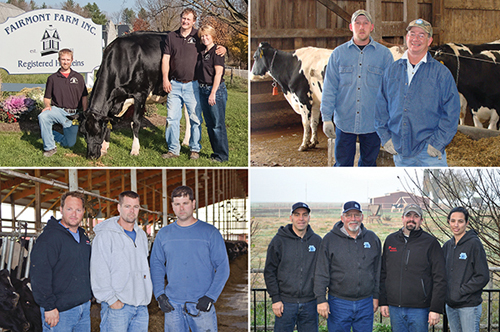by Amanda Smith, Hoard's Dairyman Associate Editor

In our February 10, 2013, issue, four producers from Vermont, New York, Wisconsin and California shared their thoughts on feeding high-forage diets to their herds. With the level of detail these producers provided, we did not have enough space in our allotted three pages to share all of their answers. Below, these producers address a key question:
Hall: Quality is king. Providing less variation becomes critical. One's forage management must be of the highest caliber. You have to understand what it takes and how your forages will meet the nutrient requirements for your cows.
Marchaland: It can be a challenge to ensure that you have adequate inventory of forages. You need about 30 percent more to avoid running short of feed. Feed bunks need to be bigger because you need to feed three to four more pounds of forage for each pound of grain taken away. Also, you should consider working with a nutritionist who knows how to balance a ration with high-quality feeds.
Ulrich: You must have high-quality, properly ensiled forages for this to work. To elevate the forage level in your diet it must be high quality and highly digestible.
van Exel: There needs to be a total commitment from the farmers, dairyman and nutritionist to produce the best quality forage. High-forage diets only work if you are able to obtain high-quality forages. Also, your nutritionist will have to be committed to sampling feeds often since adjusting diets when forages are not consistent becomes extremely important if your diets are highly leveraged towards forages.
There are a few things that I think are very important to consider when changing your feeding model:
1. Make sure that you have the ability to grow high-quality feed.
2. You must have enough water to get a complete and quality crop.
3. You need to have enough storage available to make high-quality feed that will make it through the year.
4. You must have the ability to take the crop when it is ready.
Finally, teach your team what is the right time for harvest and how you want your feed put in the bunk, bag or bale. This is often the most difficult because of the importance of quality compared to quantity and speed. We do 90 percent of harvesting ourselves, but if you don't, I think it is very important to talk to your custom harvesters early and make a plan ahead of time.

In our February 10, 2013, issue, four producers from Vermont, New York, Wisconsin and California shared their thoughts on feeding high-forage diets to their herds. With the level of detail these producers provided, we did not have enough space in our allotted three pages to share all of their answers. Below, these producers address a key question:
What challenges should others consider before raising forage levels?
Hall: Quality is king. Providing less variation becomes critical. One's forage management must be of the highest caliber. You have to understand what it takes and how your forages will meet the nutrient requirements for your cows.
Marchaland: It can be a challenge to ensure that you have adequate inventory of forages. You need about 30 percent more to avoid running short of feed. Feed bunks need to be bigger because you need to feed three to four more pounds of forage for each pound of grain taken away. Also, you should consider working with a nutritionist who knows how to balance a ration with high-quality feeds.
Ulrich: You must have high-quality, properly ensiled forages for this to work. To elevate the forage level in your diet it must be high quality and highly digestible.
van Exel: There needs to be a total commitment from the farmers, dairyman and nutritionist to produce the best quality forage. High-forage diets only work if you are able to obtain high-quality forages. Also, your nutritionist will have to be committed to sampling feeds often since adjusting diets when forages are not consistent becomes extremely important if your diets are highly leveraged towards forages.
There are a few things that I think are very important to consider when changing your feeding model:
1. Make sure that you have the ability to grow high-quality feed.
2. You must have enough water to get a complete and quality crop.
3. You need to have enough storage available to make high-quality feed that will make it through the year.
4. You must have the ability to take the crop when it is ready.
Finally, teach your team what is the right time for harvest and how you want your feed put in the bunk, bag or bale. This is often the most difficult because of the importance of quality compared to quantity and speed. We do 90 percent of harvesting ourselves, but if you don't, I think it is very important to talk to your custom harvesters early and make a plan ahead of time.








